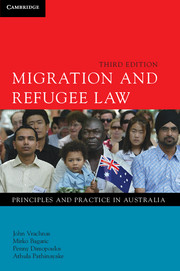Book contents
- Frontmatter
- Contents
- Table of cases
- Table of statutes
- Preface to the third edition
- Acknowledgments
- 1 Historical context to migration
- 2 Immigration control: An overview
- 3 Basic migration legislation and policy
- 4 The visa system and application procedures
- 5 Family and interdependency migration and other Australia-based visas
- 6 Business and investment visas
- 7 Skills-based visas
- 8 Temporary visas
- 9 Miscellaneous visas
- 10 Common visa requirements
- 11 Compliance: Unlawful non-citizens, removal and deportation
- 12 History of the Refugees Convention and definitional framework
- 13 Refugee and humanitarian visas: The statutory structure
- 14 Convention grounds
- 15 Persecution
- 16 Well-founded fear of persecution
- 17 Limits on protection of refugees – cessation, exclusion exceptions and protection by another country
- 18 Time for a fundamental rethink: Need as the criterion for assistance
- 19 The determination and review process for migration and refugee decisions
- Index
- References
5 - Family and interdependency migration and other Australia-based visas
Published online by Cambridge University Press: 05 June 2012
- Frontmatter
- Contents
- Table of cases
- Table of statutes
- Preface to the third edition
- Acknowledgments
- 1 Historical context to migration
- 2 Immigration control: An overview
- 3 Basic migration legislation and policy
- 4 The visa system and application procedures
- 5 Family and interdependency migration and other Australia-based visas
- 6 Business and investment visas
- 7 Skills-based visas
- 8 Temporary visas
- 9 Miscellaneous visas
- 10 Common visa requirements
- 11 Compliance: Unlawful non-citizens, removal and deportation
- 12 History of the Refugees Convention and definitional framework
- 13 Refugee and humanitarian visas: The statutory structure
- 14 Convention grounds
- 15 Persecution
- 16 Well-founded fear of persecution
- 17 Limits on protection of refugees – cessation, exclusion exceptions and protection by another country
- 18 Time for a fundamental rethink: Need as the criterion for assistance
- 19 The determination and review process for migration and refugee decisions
- Index
- References
Summary
Overview
The migration legislation provides for several categories of family migration on the basis that the visa applicant is a relative (within a defined degree) of the sponsor or has an interdependent relationship with the sponsor. That is, the visa categories in the family stream are predicated on a relationship, and each visa necessarily involves two parties, namely the applicant and the applicant's sponsor or nominator. In addition, the visa application might include members of the applicant's family unit. In general, the latter are not required to meet all criteria for a particular application and are not the subject of discussion in this chapter. They are assessed on the basis that they are, in fact, members of the family unit and meet secondary criteria related to health and character requirements, as alluded to in the previous chapter (at 4.5).
The visa subclasses for applicants migrating from overseas under the family categories are: Partner (100); Child (101); Adoption (102); Parent (103); Aged Dependent Relative (114); Remaining Relative (115); Carer (116); Orphan Relative (117); Designated Parent (118); and Contributory Parent (143). Most of these family stream visas for migrants from abroad have an equivalent visa for onshore applicants: Partner (801); Child (802); Aged Parent (804); Aged Dependent Relative (838); Remaining Relative (835); Carer (836); Orphan Relative (837); and Contributory Aged Parent (864).
- Type
- Chapter
- Information
- Migration and Refugee LawPrinciples and Practice in Australia, pp. 53 - 84Publisher: Cambridge University PressPrint publication year: 2011



